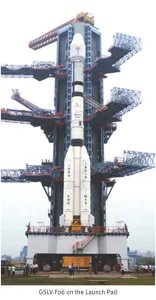Space exploration has its moments of sheer ecstasy but it can be terribly unforgiving as well. Just 63 seconds into the launch of India’s most advanced rocket, the Geosynchronous Satellite Launch Vehicle (GSLV), on December 25, 2010, scientists at the Satish Dhawan Space Centre at Sriharikota reluctantly pressed the self-destruct button triggering an explosion that destroyed the launch vehicle. The costly GSLV-F06 rocket, carrying its precious payload, the GSAT-5P communications satellite, failed to develop its rated thrust and veered off course, rendering its destruction inescapable. It was not the kind of Christmas that the Indian Space Research Organisation (ISRO) may have hoped for.
Eight months earlier, on April 15, 2010, the GSLV D-3 strayed from its designated course and went spinning out of control. After a flawless lift-off, the crucial cryogenic upper stage underperformed, sending the rocket and its payload, the GSAT-4 communications satellite, crashing into the sea 293 seconds after launch. This had been an eagerly awaited mission because the launch vehicle featured the indigenous cryogenic technology for the first time. Consequently its failure was all-the-more bitter.
ISRO also hopes to send Indian astronauts into space, to enable Indians to walk on the Moon and to mount unmanned missions to Mars.
The seeds of these twin GSLV setbacks were sown in 1992 when the US government arm-twisted Russia to cancel an agreement to transfer cryogenic technology to India, ostensibly because the technology could be used to power long-range missiles as well. As consolation, the Russians agreed to sell India seven cryogenic upper stages off-the-shelf. In the meantime, ISRO vowed to indigenously develop the cutting-edge cryogenic technology that only five entities—the United States, Russia, the European Space Agency, China and Japan—have mastered.
ISRO is keen to launch heavy satellites entirely on its own. When it performs according to plan, the powerful GSLV takes just 1,022 seconds to inject a satellite into Geosynchronous Transfer Orbit (GTO). From there, the satellite’s onboard propulsion system can take it to its intended Geosynchronous Earth Orbit (GEO) almost 36,000 km from the Earth. ISRO also hopes to send Indian astronauts into space, to enable Indians to walk on the Moon and to mount unmanned missions to Mars. All these projects are feasible only if a reliable launch vehicle of the GSLV class is available.
But six out of seven Russian cryogenic stages have been expended, the storehouse is almost bare, and the indigenous cryogenic engine is yet to taste success. So what next for India’s space endeavour?
A Long, Rocky Road
The national space programme is almost half a century old. In 1962, the Government established the Indian National Committee on Space Research (INCOSPAR) under Dr Vikram Sarabhai. ISRO was formed on August 15, 1969, in order to bring all the country’s space activities under one umbrella. Six years later, on April 19, 1975, the first indigenous Indian satellite named Aryabhata (after the great ancient Indian mathematician) was launched with the help of the USSR. And on July 18, 1980, Satellite Launch Vehicle-3 (SLV-3), was successfully launched, placing a 35-kg Rohini satellite, RS-1, in Low Earth Orbit (LEO). The next space rocket to emerge from ISRO’s stable was the Augmented Satellite Launch Vehicle (ASLV), which was intended to demonstrate and validate critical technologies. Its first developmental flight took place on March 24, 1987. The ASLV was designed as a low-cost intermediate vehicle to launch 150-kg satellites into 400 km circular orbits. However, both the SLV and ASLV programmes met with mixed success since every alternate mission failed on the average.
“¦these failures (and others before them) drive home the point that ISRO still has some distance to go before it can claim to have mastered cryogenic engine technology.
This unsatisfactory record was transformed by the more powerful Polar Satellite Launch Vehicle (PSLV)—ISRO’s first operational launch vehicle, capable of launching a 1600-kg satellite in a 620-km sun-synchronous polar orbit or a 1050-kg satellite in GTO. Its first launch in September 1993 failed, but ISRO carried out a detailed project review with the intention of remedying its shortcomings. Subsequently the PSLV, designed and developed by the Vikram Sarabhai Space Centre in Thiruvananthapuram, has proved its reliability and versatility through an amazing 17 consecutive successful launches, the last being on April 20, 2011. It has launched 44 satellites (19 Indian and 25 foreign) including four Cartosats and two Resourcesats into a variety of orbits. It was successfully adapted for India’s maiden moon mission Chandrayaan-I in October 2008. Naturally it has earned the reputation of being ISRO’s workhorse.
Though the PSLV can be termed an unqualified success, the GSLV, on which depend many ambitious Indian space goals, is yet to prove its reliability. The GSLV is ISRO’s heaviest launch vehicle yet, capable of putting a payload of 2000 to 2500 kg into GTO. Most of its major components have already been proven in the consistently successful PSLV launchers, including the S125/S139 solid booster and the Vikas L40/L35.5 liquid fuel motors. The GSLV was designed to enable India to launch INSAT-type communications satellites and to make the country less dependent on foreign launch vehicles. Its first flight was on April 18, 2001. However, only two of the seven GSLV launches to date have been flawless, while two other missions met with partial success.





